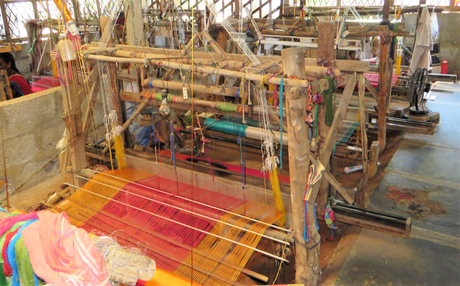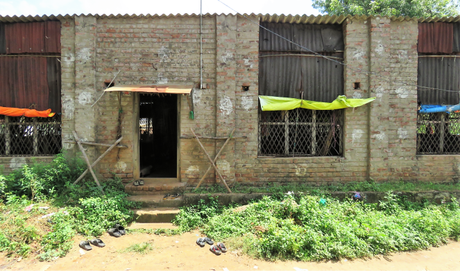Given my love for indigenous textiles, I never miss an opportunity to visit handloom weaving centres during my travels. In line with the country’s rich footprint of textiles, the southern states of Andhra Pradesh and Telegana are prominent torch bearers too. Apart from the Ikkat, Kalamkari, Gadwal and Narayanpet, the elegant sarees of Mangalagiri have earned a special place not only in India but also abroad. The origin of these sarees is the town of Mangalagiri in Guntur district whose name translates into “Auspicious hill”. Located on the Guntur-Vijayawada highway, the town whose population is about a lakh, is situated about 15 km from Vijayawada and is synonymous with the Panaka Narasimha swamy temple that is located atop a hill in the town.
 Mangalagiri town
Mangalagiri town
With a majority of the population belonging to Padmashali/Padmasali community whose traditional occupation is weaving and textile business, it is no surprise that weaving is the most important industry here apart from paddy cultivation. The town has over 5000 weavers and over 50 outlets selling the famous Mangalagiri sarees, dress materials and salwar sets in silk, cotton and cotton-silk. The weavers work out of either indigenous sheds many of which are located about 5 km from the town center in an area called Ratnala Cheruvu or from their homes in the nearby villages. They either work for dedicated wholesalers or supply to multiple outlets.

Distinguishing features
Made from pure cotton yarn, Mangalagiri fabric is known for its durability, softness and elegance. This is due to the fact that most of the materials are made up of 80*80 counts while few of them are of 60*40 count. The count here is a measure of the number of threads woven length (warp) and breadth wise(weft). Moreover, the fabric is woven tightly over pit looms with the weavers sitting at ground level with their feet firmly below the ground. This lends the fabric the soft texture and a characteristic sheen. “The fabrics are breathable, light on the skin and great for all climates including summer” says Durga, a native of the town who runs an outlet called Poorna Sarees along with her father.

Another key feature of Mangalagiri sarees are their famous traditional zari borders, also known as Nizam borders that are about two inches thick. The sarees that are woven in bright hues have a thick gold border that has some very closely-knit patterns like tiny inverted checks. The zari in these hallmark borders is superimposed by weaving them over the regular weave unlike many handlooms where the zari itself is woven alone as the border. The body of the fabric has minute checks, stripes and devoid of any large woven patterns lending it a crisp, simple yet dignified look.


Elaborate process
The raw material i.e the cotton yarn is sourced locally largely from Guntur district, Tamil Nadu and even APCO while the zari comes from various cities like Ahmedabad, Surat and Bangalore. The yarn is first cleaned by removing impurities like seeds, oil, wax etc by boiling it with soap and soda. This also removes the stickiness of the yarn. It is then made ready for the most important step which is dyeing. While vat dyes are mainly used for coloured sarees, white sarees are bleached.


The most important feature here is that the Warp and Weft are dyed separately. The yarn is then washed, dried and starched after which it is distributed to weavers. Next it is loaded onto a charka where the yarn is transformed in thread forming the warp and weft with the help of shift bamboo, pirn and bobbins. “It is indeed a complex process and there is the handiwork of at least 30 people before the yarn is ready for weaving” says Durga.
Weaving
The traditional Mangalagiri sarees are woven using pit looms wherein a pit is dug into the ground and the pedal of the loom is placed under the ground. The weavers who normally acquire this skill from their ancestors sit on the floor and use their hands and legs to operate the loom. With their feet firmly planted below the ground, weavers are able to apply the right kind of pressure to ensure the tightness of the weave that makes the fabric and zari thick and closely-knit sans any gaps.

This is the quality that sets these sarees apart and due to this fact, there is a high demand for these sarees. “We have very good turnover and due to the growing demand, we have partnered with vendors to sell our sarees online” says Ramu of Srinivasa Handlooms who work closely with weavers and procure as many as 50 sarees a week.
Challenges
But like all handlooms, this is a laborious process that is labor intensive. “Each saree takes about 1.5-2 days to complete and the workers earn around Rs. 200 a day for their efforts. This is definitely not so lucrative and hence weavers are on the lookout for jobs that are easier and pay better. Since weaving using pit looms is tough, power looms have mushroomed these days. Using the latter, sarees are churned out in large numbers and are less expensive but they not authentic” quips Durga.

Outlets like theirs face competition from the ones selling sarees using power looms which is partially the reason why the number of outlets have multiplied in the last decade. “When we started in the early 2000s, we were only the second shop but now there are 52 shops here” adds Durga.
A more detailed version of this article was originally published in Deccan Herald. To read more about indigenous arts and crafts of India, click here and here.
